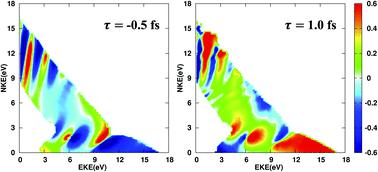当前位置:
X-MOL 学术
›
Faraday Discuss.
›
论文详情
Our official English website, www.x-mol.net, welcomes your
feedback! (Note: you will need to create a separate account there.)
Attosecond laser control of photoelectron angular distributions in XUV-induced ionization of H2
Faraday Discussions ( IF 3.3 ) Pub Date : 2020-11-11 , DOI: 10.1039/d0fd00114g Roger Y. Bello 1, 2, 3, 4 , Fernando Martín 5, 6, 7, 8, 9 , Alicia Palacios 5, 6, 7, 8, 9
Faraday Discussions ( IF 3.3 ) Pub Date : 2020-11-11 , DOI: 10.1039/d0fd00114g Roger Y. Bello 1, 2, 3, 4 , Fernando Martín 5, 6, 7, 8, 9 , Alicia Palacios 5, 6, 7, 8, 9
Affiliation

|
We investigate how attosecond XUV pump/IR probe schemes can be used to exert control on the ionization dynamics of the hydrogen molecule. The aim is to play with all available experimental parameters in the problem, namely the XUV pump–IR probe delay, the energy and emission direction of the produced photo-ions, as well as combinations of them, to uncover control strategies that can lead to preferential electron ejection directions. We do so by accurately solving the time-dependent Schrödinger equation, with inclusion of both electronic and nuclear motions, as well as the coupling between them. We show that both the IR pulse and the nuclear motion can be used to break the molecular inversion symmetry, thus leading to asymmetric molecular-frame photoelectron angular distributions. The preferential electron emission direction can thus be tuned by varying the pump–probe delay, by choosing specific ranges of proton kinetic energies, or both. We expect that similar control strategies could be used in more complex molecules containing light nuclei.
中文翻译:

XUV诱导的H2电离中的光电子角分布的阿秒激光控制
我们研究如何使用阿秒XUV泵浦/红外探针方案来控制氢分子的电离动力学。目的是解决问题中所有可用的实验参数,即XUV泵-IR探针延迟,产生的光离子的能量和发射方向以及它们的组合,以发现可能导致优先电子喷射方向。为此,我们可以精确地求解与时间相关的Schrödinger方程,其中包括电子运动和核运动,以及它们之间的耦合。我们表明红外脉冲和核运动都可以用来打破分子反转对称性,从而导致不对称的分子框架光电子角分布。因此,可以通过改变泵浦-探针延迟,选择特定范围的质子动能或两者来调整优先电子发射方向。我们期望类似的控制策略可用于包含轻核的更复杂的分子。
更新日期:2020-11-11
中文翻译:

XUV诱导的H2电离中的光电子角分布的阿秒激光控制
我们研究如何使用阿秒XUV泵浦/红外探针方案来控制氢分子的电离动力学。目的是解决问题中所有可用的实验参数,即XUV泵-IR探针延迟,产生的光离子的能量和发射方向以及它们的组合,以发现可能导致优先电子喷射方向。为此,我们可以精确地求解与时间相关的Schrödinger方程,其中包括电子运动和核运动,以及它们之间的耦合。我们表明红外脉冲和核运动都可以用来打破分子反转对称性,从而导致不对称的分子框架光电子角分布。因此,可以通过改变泵浦-探针延迟,选择特定范围的质子动能或两者来调整优先电子发射方向。我们期望类似的控制策略可用于包含轻核的更复杂的分子。











































 京公网安备 11010802027423号
京公网安备 11010802027423号